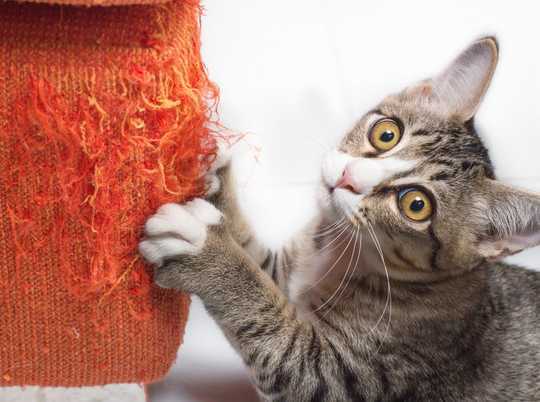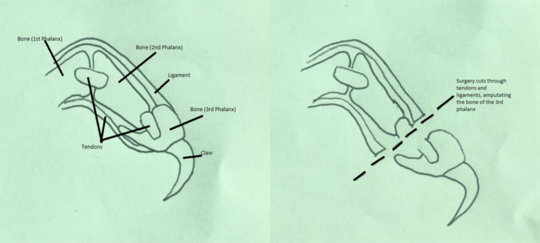
Scratching is a natural behavior for cats. noreefly/Shutterstock.com Ilana Halperin, University of California, Davis
Declawing a cat might sound as simple as trimming your pet’s nails. But it’s actually major surgery.
A veterinarian cuts through the joint to amputate part of the cat’s toes, from the last knuckle out to the tip of the claw.

Declawing amputates the bone at the tip of the cat’s paw along with the claw. Ilana Halperin, CC BY-ND
Scratching things is a natural behavior for cats. It lets them get healthy stretching exercise and also provides stress relief.
A cat might accidentally scratch you while playing. Or a cat might aggressively lash out with its claws. A pet owner usually chooses onychectomy, as declawing surgery is technically called, to prevent scratching injuries to people or damage to objects.
Declawing will not address the real issue causing a cat to behave aggressively, so the risk of injury from biting remains. One study found that almost 50% of cats occasionally display aggression toward both people they know and strangers.
This surgery comes with risks of complications. Right after being declawed, the cat will be in pain. Vets will prescribe medicine to help manage the immediate pain. There may also be bleeding, swelling and infection.
One study found that 42% of declawed cats had ongoing long-term pain and about a quarter of declawed cats limped. In up to 15% of cases, the claws can eventually regrow after the surgery.
Once a cat is declawed, it must stay indoors only. Removing the claws removes the cat’s main way to defend itself and climb well.
Some pet owners see declawing as their last option before getting rid of a cat that scratches. The American Veterinary Medical Association “strongly encourages” people to learn more about the procedure before signing a cat up. It’s possible an owner might not understand normal scratching behavior or how serious the surgery is.
Many veterinarians, including me, do not perform declawing surgery. In most cases it’s because they feel the elective procedure is not medically necessary and that it’s not a humane choice for cats.
Declawing is illegal in some American cities, including Los Angeles and Denver, and the state of New York. The U.K., Australia and many parts of the European Union and Canada have also outlawed declawing.

Frequent nail trimming and protective nail caps can go a long way toward cutting down on scratching damage. Alena Ozerova/Shutterstock.com
If you have a cat that just won’t stop scratching, there are some other solutions. Frequent nail trimming and the use of plastic nail caps over the cat’s claws can help. Offering scratching posts and other forms of environmental enrichment can also reduce scratch damage. Veterinarians can prescribe therapies to reduce feline anxiety, too, including medications and pheromone diffusers that spread calming chemicals that cats naturally release.
Living with a cat comes with the responsibility to keep that pet healthy and content. That means finding a fair balance between protecting the health of family members and that of the household cat. It may also mean coming to terms with the idea that some cats express their normal need to scratch on the furniture. Fortunately, veterinarians are available to discuss options to keep everyone in the household comfortable and happy.
About The Author
Ilana Halperin, Health Sciences Assistant Clinical Professor in Community Practice, School of Veterinary Medicine, University of California, Davis
This article is republished from The Conversation under a Creative Commons license. Read the original article.
Books on Pets from Amazon's Best Sellers list
"The Beginner's Guide to Dog Agility"
by Laurie Leach
This book is a comprehensive guide to dog agility, including training techniques, equipment, and competition rules. The book includes step-by-step instructions for training and competing in agility, as well as advice for selecting the right dog and equipment.
Click for more info or to order
"Zak George's Dog Training Revolution: The Complete Guide to Raising the Perfect Pet with Love"
by Zak George and Dina Roth Port
In this book, Zak George offers a comprehensive guide to dog training, including positive reinforcement techniques and advice for addressing common behavior issues. The book also includes information on selecting the right dog and preparing for the arrival of a new pet.
Click for more info or to order
"The Genius of Dogs: How Dogs Are Smarter than You Think"
by Brian Hare and Vanessa Woods
In this book, authors Brian Hare and Vanessa Woods explore the cognitive abilities of dogs and their unique relationship with humans. The book includes information on the science behind dog intelligence, as well as tips for enhancing the bond between dogs and their owners.
Click for more info or to order
"The Happy Puppy Handbook: Your Definitive Guide to Puppy Care and Early Training"
by Pippa Mattinson
This book is a comprehensive guide to puppy care and early training, including advice for selecting the right puppy, training techniques, and health and nutrition information. The book also includes tips for socializing puppies and preparing for their arrival.
Click for more info or to order


























